Infinite Potential, Infinite Space
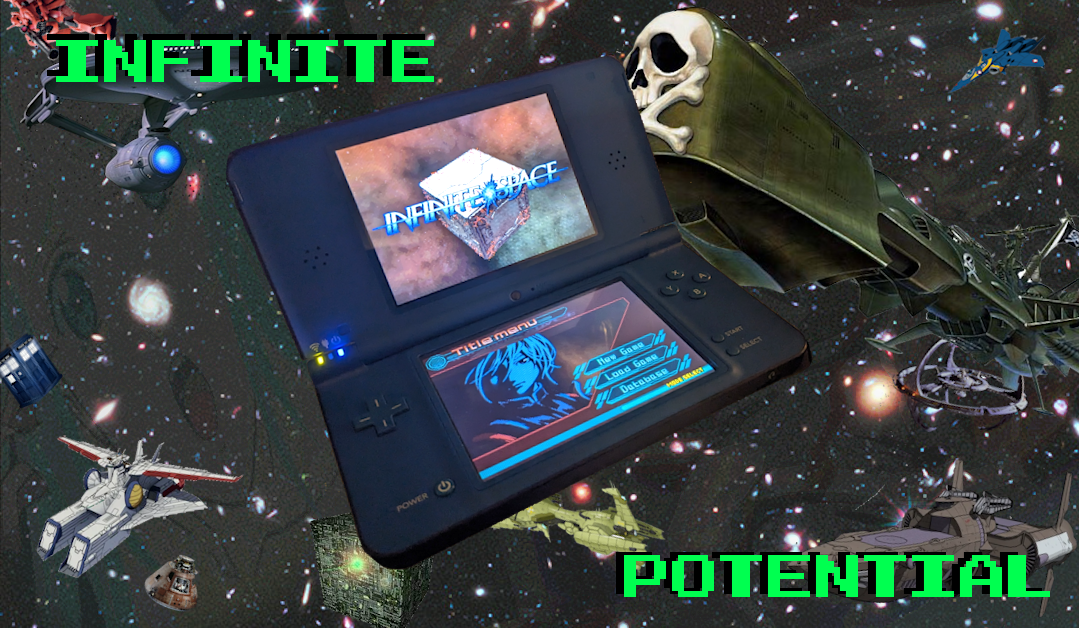
I, IMAGINATION INTERRUPT
I am flying through space in a 5-mile-long battleship-class starship – the Avalon-1 – listening to Sting’s first solo album “The Dream of the Blue Turtles,” imagining myself captain on the bridge of the most powerful starship within seven galaxies. I gaze out among the tapestry of endless night; a cloth poked full of holes that let the light in. Sting’s 1985 hit song “If You Love Somebody Set Them Free” is blaring from the bridge speakers; the crew, a rag-tag group of malcontents, are tolerant but annoyed by Sting’s intimated Jamaican regatta de blanc, insisting we should keep the noise down in case of emergency coms.
But I am the captain and, as Sting would put it, they cannot control an independent heart.
I plot our course using a small touchpad attached to my majestic captain’s chair, my preferred input method: a black stylus. Tapping little nodes on a cyberistic black and green GUI, which draws a path for my chief navigator – Papplo – to follow, ensuring the smoothest ride possible. The crew complains of boredom during these long treks through the deep depths of darkness, but that’s what imagination and loud music is for.
The build-up to Sting’s “Shadows in The Rain” swells to a fever pitch, and I begin tapping my foot and imitating an invisible drum fill while sitting in my cushioned captain’s chair. I feel the crew’s eyes burning a hole in my skull, but I ignore it. Torlo, the artillery chief, rolls his eyes extra hard.
My fleet consists of four starships. They tag along in nearby space, following my lead. As I check the monitors to ensure the fleet is in order, a large blast rocks the Avalon-1, nearly knocking me out of my chair. The warning alarms blare – we’ve been hit – and I quickly come to my senses, flipping the radar screen into view as my 1st officer – Ian Fenevich – swiftly calculates the distance of the attacker within a 2% margin of error.
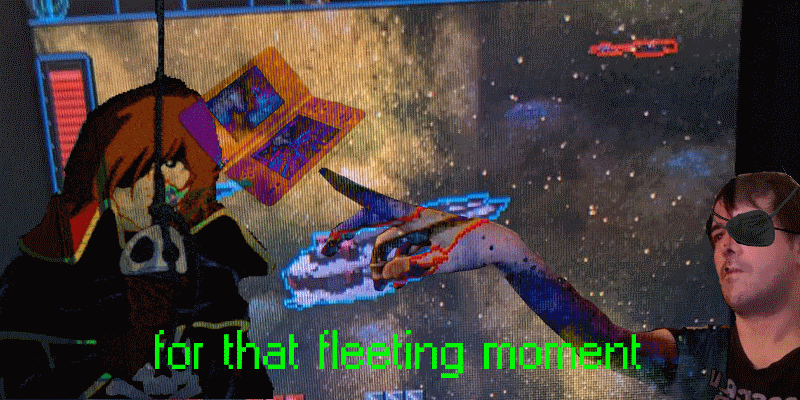 *for a fleeting moment, I am the captain
*for a fleeting moment, I am the captain
We are under attack by a small fleet of pirate starships, likely looking to loot and murder, as is their nature. This is all par for the course in the realm of the endless. After all, I became a starship captain for this very reason: freedom. Freedom of movement. Freedom to do what I want – to go anywhere I want. If killing a few pirates here and there is the price to pay for such freedom, that’s an acceptable trade-off.
Using my touchpad, I instruct my fleet to move forward toward the pirate armada, closing the gap but stopping just out of their assumed attack range while our starships build power to launch a full barrage of lasers and rockets.
“Initiate dodging procedure!” I bark from the captain’s chair as my fleet approaches the enemy.
My orders come as the pirate fleet unleashes a full volley in our direction. The Avalon-1 deftly sidesteps the enemy’s onslaught, and in that moment, the predator becomes the prey. With poised determination, I direct my crew to complete the closing of the gaps; our weapons-systems now within range of the beating pirate heart.
“Adjust cannons by 90 degrees; turn off spatial dampeners,” I declare, rising from my seat and sweeping my captain’s cape in a flourish that exudes Harlockian elegance. “All guns, verify calculating tables and force projections,” I command, a brief pause punctuating my words, “Fire!”
A glorious lightshow plays out on the bridge monitors; near-endless streams of beams and rockets zip through the darkness toward my pirate prey.
My aim is true and the artillery agrees with me.
The void of space devoid of sound, but the noise of each impact plays out in my mind as I watch each round collide with its target in spectacular violence.
I silently laugh as the enemy fleet is overwhelmed by the might of my armada. One by one, each pirate starship erupts into a momentary supernova, leaving nothing but floating scrap metal and the water vapors of once human blood.
 *the bridge of the Avalon-1
*the bridge of the Avalon-1
Suddenly, I hear my 4-month-old son crying loudly from one room over. I close the lid of the clamshell-like captain touchpad – the Nintendo DSi XL – place the console down on the nearby desk, and stand up from the captain’s chair of the Avalon-1 – the big blue couch in the corner of my garage-office.
Before leaving the room to tend to my son, I realize that I can’t stand Sting’s “Dream of the Blue Turtles,” so I stop the playback and walk out of the room, back to the real world.
A number of hours pass. The boy has been fed. He’s been amused. He’s been all smiles; but now it’s time for bed. I place the boy in his crib, swaddle him, and pop a pacifier into his mouth; and after a few minutes, his eyes go blinky-slow until he blinks no more.
The boy is asleep.
I sneak out of the boy’s room. Into the kitchen, I pour myself a glass of red – in the small glass as a form of forced pacing – and sit back down in the captain’s chair of the starship Avalon-1.
Flipping the DSi XL open once again, and I’m back. The handheld space simulator casts its digital glow upon my face, illuminating the contours of my visage in the embrace of the dimly lit garage-office of perpetual-midlife-crisis.
I tap the navigation screen, selecting three planets to traverse. The fleet progresses along a linear path from planet to planet. Sometimes, pirates cross our path; they’re swiftly decimated by my fleet’s high-powered lasers. Our journey continues on this unswerving route until I finally reach my destination.
And I’m not feeling it.
I’m not a captain.
I’m not a kid anymore.
I’m a thirty-year-old man sitting on a couch in his office.
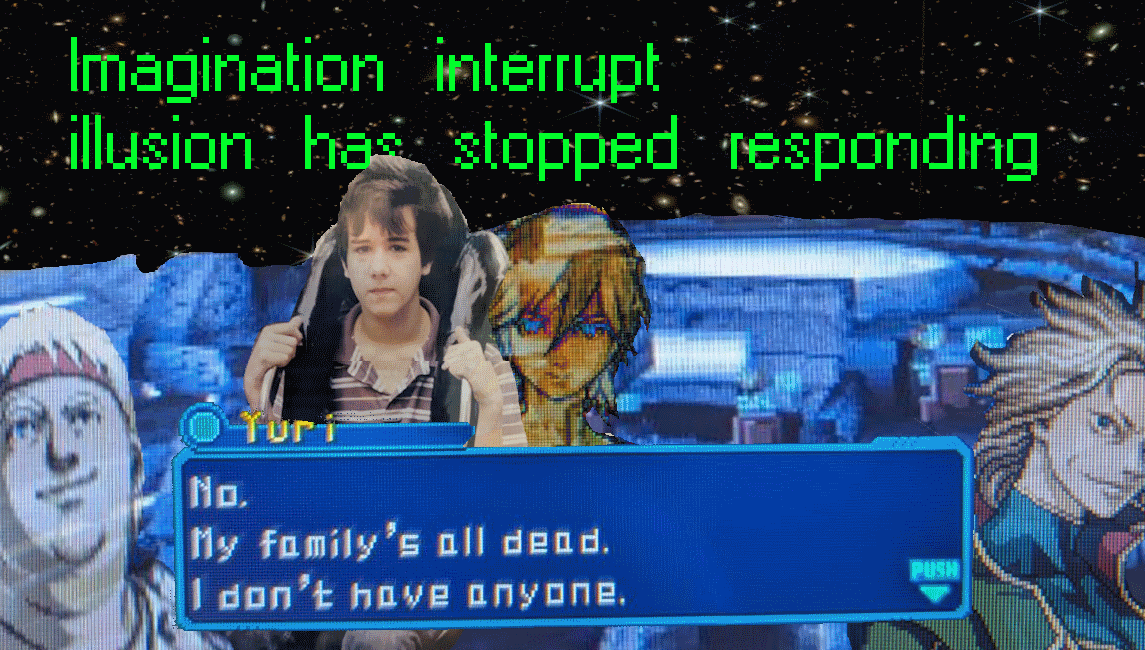 *Imagination interrupt: illusion has stopped responding.
*Imagination interrupt: illusion has stopped responding.
Some games consume you instantly; their gameplay and presentation so immediately arresting that you can’t help but fall in love at first sight.
Infinite Space is not one of those games.
Infinite Space requires a lengthy checklist of prerequisite feelings and mindspaces before it can be – even – barely enjoyed, and that illusion has to be maintained and cultivated for at least seventy-five hours spread out over several weeks.
Infinite Space requires one to be immersed in the science fiction headspace, specifically the “space opera” sub-genre. One needs to be lost in captain-delusion and starship fantasia; an obsession with Space Captain Harlock, Firefly, and Star Trek is practically mandatory. All the while, simultaneously watching the Battlestar Galactica reboot – at least one episode a day – and reading a chapter of Samuel R. Delany’s “Nova” every night before bed, preferably with those little glow-in-the-dark planets and stars tacked to the bedroom ceiling.
And if you falter in this routine for just a moment, the illusion is lost and the computer game reveals its true self. Shedding its persona, what is revealed is a dry, monotonous collection of lost potential.
Much like when you stumble upon the social media profile of your high school sweetheart and consider sending her a message; the expected outcome, the fantasy, is better than the reality. The level of abstraction needed to believe such an action is even remotely a good idea is, well, infinite.
II, ILLUSION HAS STOPPED RESPONDING
Infinite Space is about space.
More specifically, Infinite Space is about a young man’s journey through space. Even more specifically, it is about freedom: freedom of movement; freedom of choice; freedom to do what you want; and, conversely, the oppression of that freedom. Even more specific still, it is about the lengths humanity will go to preserve their freedoms, and the sacrifices and friends we made along the way. It is also a coming of age story, and a commentary on human expansion, and a critique of manifest destiny, and a commentary on perpetual violence, and an attack on rampant capitalism, and a love story.
Infinite Space aspires for everything and only manages to achieve something, and what that “something” is, well, I don’t know – maybe we’ll figure it out, together.
Infinite Space is a computer game aiming for such great heights: the distinction of being labeled a “space sim” on a Nintendo console, something that had never been attempted before and something that has – still – never been successfully accomplished.
Space sims, the ultimate expression of computer-game-freedom; as such, one might expect a fully customizable experience, including a customizable main character; yet, that is not the case. Instead, we are Yuri, a fresh 16-year-old boy trapped on the planet Ropesk – a planet founded by a once-and-future-washed-up has-been named Demid Panfilov, who at some point killed Yuri’s father – or something.
The point is, Yuri’s got no parents. He’s got no friends. His life sucks, and I am completely disconnected from him – imagination interrupt; illusion has stopped responding.
 *space sims: the origin; one of these things is not like the other
*space sims: the origin; one of these things is not like the other
As space travel is easy, consumer-friendly, and abundant in the space of Infinite Space, and thanks to galactic expansion laws: anyone who discovers a planet can rule that planet as they see fit. Our hero had the misfortune of being born on a planet ruled by a despot who forbids space travel; quelling the freedoms of those who live on Ropesk with threat of death.
Before Yuri’s father’s freedom-yearning demise, he gave Yuri a small metallic box: a mysterious ancient device known as an “Epitaph,” said to possess great power. Naturally, this box is a macguffin that becomes important later in the overarching plot, but it also serves as a kick-off point for Yuri’s spacefaring curiosity – the ultimate “what does this button do and how do I find out?”
Yuri, who idolized his spacefaring father and wants to escape into the deep darkness of space, sends out a galactic message to a “Launcher,” an outlaw who helps people escape space tyranny, they assist the oppressed-little-guys by launching them into space (hence the name), and those who successful make it into space are known “Zero G-Dogs.”
The ‘G’ stands for ‘gravity,’ duh.
One fateful day, Nia – the Launcher – gets Yuri’s message, swoops down to Ropesk, and picks him up. Through a series of wheelings-and-dealings, particularly the secret pawning of Yuri’s epitaph, Nia secures Yuri a starship of his own; thus, our – no, Yuri’s – adventure begins.
I am not the hero of this story, neither are you.
Yuri, at the ripe age of sixteen, is finally a Zero-G Dog, free to traverse the universe as he sees fit, and that’s just chapter one of this seventeen chapter space opera epic coming of age existential political commentary that unfolds throughout the almost one-hundred-hour playtime of Infinite Space.
And the rest is exposition.
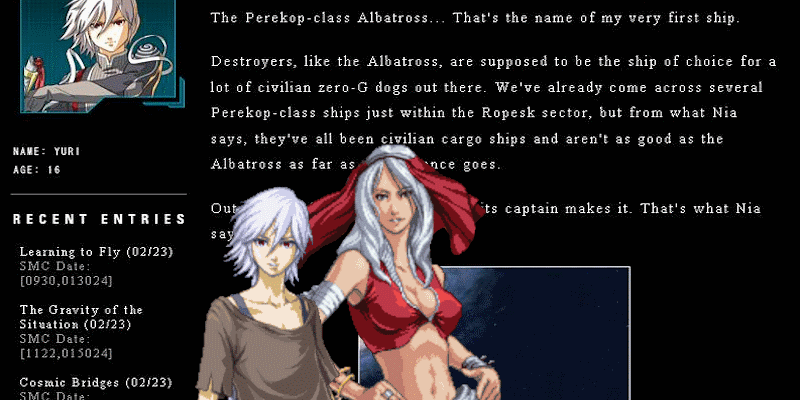 *a boy and his blog
*a boy and his blog
Infinite Space is the type of game with a lot of internal terminology. A dictionary in the help menu. It’s the type of game with a three-page historical timeline outlining the rise of humanity, the advent of space travel, numerous spacefaring wars, and all the space-empires involved along the way. It’s the type of game that gets you excited to dive in and start learning – even before starting the actual game.
Infinite Space casts a long shadow of intrigue over the player, much like Yuri’s epitaph.
The idea to fall in love with. The idea of being a starship captain traveling the vast expanse of space is just too strong to resist.
So intimidating is Infinite Space that one – such as myself – might be inclined to download the “Zero-G Dog Starter Guide” from some long-forgotten source on the internet. One – such as myself – might read every page of that starter guide, absorbing every ounce of Infinite Space’s lore before starting a new game.
Because surely, a space simulator marketed as having over 200 recruitable crew members and over 150 customizable starships has to be – must be – a deep and engaging game with complex systems that need to be learned and fully understood before hoping to achieve even a modicum of computer-game-success, right?
Wrong.
The core gameplay loop of Infinite Space is revealed within the first hour of gaining control of Yuri’s first starship, and it never changes; once you’ve experienced the first hour, you know what you’re going to be doing for the next hundred hours.
Infinite Space is traveling from planet to planet, navigating the “tavern” menu to talk to the barkeep or some other person, then traveling to the next place to complete the aforementioned person’s request, while sometimes encountering enemy starship fleets that must be destroyed along the way. Sometimes you have to talk to the barkeep six times in a row before he gives you the next story-progressing task. Sometimes you go into a menu-based-building and traverse some corridors.
Then you do it again, and again.
Space travel in Infinite Space is controlled by the bottom touchpad on the Nintendo DS. Each planet, asteroid belt, moon, hunk of space metal, brain in a vat, and anything else you can think of is a blue node on a star chart. You – the player – tap the blue nodes; sometimes you’ll tap one node, sometimes you will tap six nodes, all interconnected, to form a navigation path for your fleet.
Once you plot your path, your – Yuri’s – fleet pilots itself through the selected route. You can also fast-forward the traveling animation or stop it completely to plot a new course; consequently, space travel is mostly a hands-off experience, as you observe Yuri’s fleet coasting from point A to point B and back again, then around the bend, and back once more.
The lengthier your journey, the more fatigued your fleet – and the crew – becomes, exerting a negative influence on your battle performance. This aspect is crucial due to the prevalence of random battles. However, the majority of these skirmishes can be bypassed if necessary. Yet, it’s worth noting that grinding through battles remains one of the few dependable avenues to grind money for new starships, likely leading you to opt for engagement with every encountered enemy fleet simply out of necessity.
And battles are very important. Monotonous, but important. Combat utilizes both the top and bottom screens of the Nintendo DS – the bottom for inputs and the top to watch those inputs play out in real-time; it’s a largely hands-on experience, contrasting the mostly hands-off experience of ship-navigation.
Combat is so hands-on that you will often find yourself in the Nintendo-DS-claw position: using your left pinky to hit the triggers, your left thumb for directionals, and your right hand to hold the stylus and press the face button simultaneously; a unique experience only made possible by the insane minds at Nintendo.
 *bottom screen on the left, top screen on the right; also claw.
*bottom screen on the left, top screen on the right; also claw.
The captain – Yuri – utilizes the touchpad to input commands to the fleet, with a command gauge accumulating over time; said “command gauge” dictates the use of various actions. Numerous special attacks exist, but the fundamentals – “normal,” “barrage,” and “dodge” – are most important. “Normal” fires each of your fleet’s weapons once and uses one chunk of the command gauge; most effective when the enemy selects the “dodge” command. “Barrage” discharges every weapon three times, inflicting massive damage and consuming three chunks of the command gauge. Being struck by a “barrage” is a death sentence for any starship; however, it can be easily avoided using the “dodge” command, which consumes one chunk of command gauge and expires after any other action, underscoring the importance of carefully timing “dodge” to achieve victory.
But that’s not all: distance is important too. Each weapon possesses a distinct attack range, making fleet positioning crucial for weapon accuracy, evasion, and launching counterattacks. As such, there exist “forward” and “backward” buttons on the bottom touchpad, both of which will be utilized liberally to position your fleet relative to the enemy, utilized so much that the risk of denting the touchpad is all too real.
Infinite Space fleet combat resembles a cat-and-mouse game infused with simplified rock-paper-scissors dynamics; and, it never changes.
The typical space battle in Infinite Space plays out as such: use “dodge,” accelerate toward the enemy but stay just out of range of their weapons systems, idle until you build up enough command energy to launch a “barrage,” accelerate within range of the enemy, at this point enough time has passed that the enemy will try to “barrage” but you have “dodge” selected, so you avoid their “barrage” completely, you then use “barrage” yourself, destroy one of their ships, then fly backwards out of range only to repeat the process.
This cat and mouse game plays out on the top screen in glorious three dimensions, showcasing the excellent starship designs and detailed attack animations.
And, each time an attack is launched, a bridge crew-member – presumably Yuri himself – yells out attack orders while a cinematic cutscene plays out: “successive fire pattern four four nine, turn off spatial dampeners, fire!”
It’s all very epic. It’s all very televised, theatrical.
Each laser and rocket is depicted firing from each starship within the fleet, which can eventually consist of up to five different starships, each equipped with four to five distinct weapons. When you choose the “barrage” option at that stage, you will witness your fleet launching a total of twenty-five different attacks (five times five), followed by the spectacle of these twenty-five attacks converging upon your selected target, the latter of which is a separate scene; this means, in this specific scenario, you will witness lasers and rockets doing – something – a grand total of fifty times.
Needless to say, watching this unfold on screen takes upwards of twenty-seven years.
These scenes are a visual spectacle early on but quickly become a chore to watch; the developers presumably knew this too, as you can skip through them, turning late-game battles into endless skip-fests where you don’t see any animations, only the wreckage left in the aftermath.
 *keeps going and going and going and going and going and going
*keeps going and going and going and going and going and going
But that’s not all – melee battles, essentially timed rock-paper-scissors encounters; initiated by flying in close proximity to the enemy ship and tapping the melee button. These melee battles unfold in a methodical cycle, involving the simple anticipation of whether the opponent will opt for “slash,” “shoot,” or “leader” – or, as you may have deduced: rock, paper, or scissors. Certain conflicts can only be triumphed through a melee approach, while a handful of planet-based adventures require melee battles to advance.
Success in both space warfare and melee combat is dictated by the state of your starships, which are fully customizable through Tetris. Using O-I-J-T-L tetrominos, you plug add-ons into your starship. Each starship has a unique amount of space to accommodate the add-ons.
It’s not complicated; however, somehow figuring out how to fit specific tetrominos becomes a puzzle more engaging than the actual combat you employ the tetrominos for.
Like a ghost in the machine, the tetrominos do not bring about any physical changes to the appearance of your starship; they simply enhance hidden stats – another state of detachment; a false advertisement.
The advertised 200 crew members include some who can be entirely missed if you don’t engage in conversation with the right person in the right tavern twelve times in a row at the right time, while others are mandatory for story progression.
Similar to Suikoden’s 108 Stars of Destiny, the count here is 200, but the characters are far less unique. Unlike the celebrated Konami role-playing game, these characters are not usable in combat, essentially becoming names on a long list. Much like the add-ons you clinically insert into your ship, they serve as stat-sticks to enhance the ship’s statistics behind the scenes; place Ian in the 1st officer slot due to his high leadership stats, and place Kira in the cafeteria because she knows how to cook, thereby enhancing the crew’s livability.
Just like tetrominos, it’s not complicated, and it’s a nice touch – yet it remains detached, offering only subtle hidden statistical benefits. You hope that placing Torlo in the right spot actually accomplished something; but did it truly? The benefits of your decisions are not easily discernible.
We place our faith in the backend systems.
 *tetrominos falling into place; not at all a Radiohead experience
*tetrominos falling into place; not at all a Radiohead experience
Infinite Space is the most clinically detached computer game that I have ever played.
Advertised as a fully customizable experience, but this is fraud. There is customization here, but it’s shallow and number-crunching. While there are more than 150 ships to outfit your fleet, they follow a linear progression line: more expensive ships are better, so use those. And while the ships themselves can be customized internally, they cannot be customized aesthetically.
Much like Excel spreadsheets, which are also numerically customizable – only the most self-hating middle-manager finds true enjoyment in this activity; and that’s only true because there may be a raise at the end of fiscal year.
The freedom Infinite Space does provide is narrative-based, and this is where the game shines – dimly.
Throughout the journey, Yuri is given the option to make choices at key moments to influence the plot. A majority of these choices are meaningless, such as “do you want to help?” and selecting “no” essentially functions as a sneaky way of selecting “yes.”
“Haha, you’re so funny, Yuri – come on, help me out!”
Computer game trickery that may fool the young at heart – but not this seasoned loser.
And while a number of false choices exist in Infinite Space, there are also choices that impact pivotal plot points, such as choosing which faction to assist during a crossroads in the middle chapters of the game, or deciding whether to spare or kill certain characters. The latter of which can influence which crew members you recruit later on.
These are all nice touches for a game about freedom, but the superficial choices are far more abundant than the meaningful ones.
If Infinite Space excels at anything, it’s storytelling, especially in the late game. We witness Yuri grow from a sixteen-year-old awkward kid, with his entire crew believing he’s immature, to making hard choices, falling in love, and being forced to grow up. Yuri’s transformation occurs in almost real-time
The story itself is Xenosagian in its presentation and tone, containing an endgame twist that puts the entire plot into relative perspective, but it never reaches levels of philosophical ponderance or existentialism that Tetsuya Takahashi accomplishes; yet, that doesn’t matter as Infinite Space is ultimately about growing up.
Infinite Space is not about you. It’s about Yuri and his coming-of-age story, all set against a sci-fi space-opera themed backdrop.
And halfway through the game, Yuri grows up. His sprite changes too, as does the entire crew – an excellent computer game trope that should be used more often. Yuri’s transformation into adulthood is completely believable and relatable, and that aspect is the “something” Infinite Space excels at; we’ve figured it out – together!
But has anything really changed?
Yuri’s glow-up doesn’t save this otherwise clinical and repetitive computer game from ultimate obscurity.
Infinite Space is grand in scope, a cult classic contender, only lacking the spooky-hooded-cult-members; a game so lost in itself that it doesn’t even bother to include a quest log, leaving the player just as lost as the game itself every time they boot up their save.
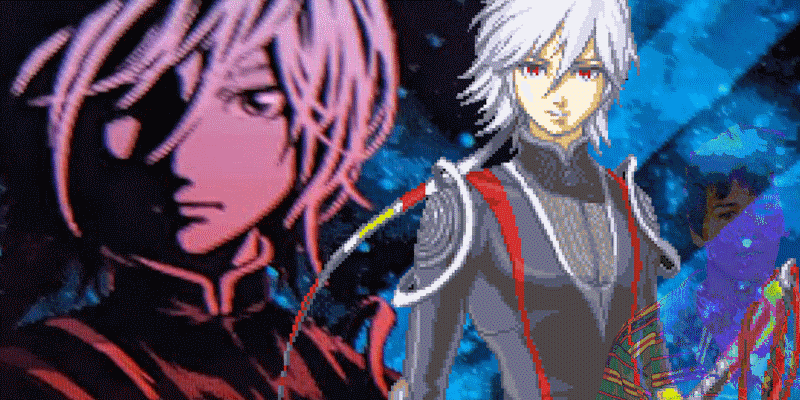 *the boy and the man
*the boy and the man
In 2013, the apartment I shared with two other people lacked a washing machine. I often found myself sitting in a laundromat, playing Infinite Space on my blue Nintendo DSi XL. In this time capsule, I tapped around on the touchpad, went to the tavern, talked to some random NPC several times to obtain an objective, flew my starship to the next planet over to complete that objective, fought some pirates attempting to gank me in a repetitive dance of cat and mouse, and did it all over again, and again; ever unchanging.
While the absurdly long attack and travel animations played out on the dual screens, I gazed up at my chosen washing machine. Having just put a few quarters into the machine, I watched my clothes spin in a repetitive dance of cat and mouse, the socks never catching the shirts.
I closed the Nintendo DS – choosing to watch the washing machine’s spin-cycle instead, a far more entertaining spectacle.
Ten years later, I’ve grown up. I have two kids. I am playing Infinite Space on the same Nintendo DS that I had ten years ago.
I close the Nintendo DS – nothing has changed.
(Originally published on 8/26/2023)